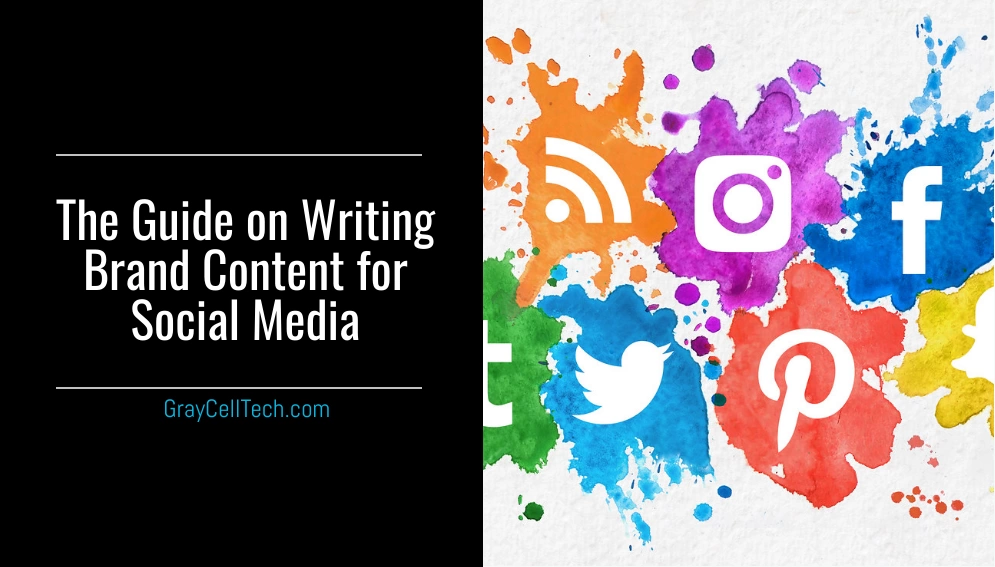Quality content is the king of social media. If you consistently provide interesting, informative, and inspiring content to your customers, you’re halfway to huge success.
When we talk about creating brand content for social media, we mostly include writing post copy, designing visual components, and editing photos. Of course, everything you do on your social media channels as a brand will be customized for your target audience.
Who can benefit from this guide?
- Online store owners
- Business owners
- B2C and B2B advertisers
- Marketers
- Bloggers
In this guide, we are presenting you with a simple and complete overview of the basics of social media brand marketing. Follow this advice to boost the success of your brand’s marketing efforts:
Set SMART Goals for Your Social Media Content

Before you start developing your brand content for social media, first you need to compose a plan that will be used as a strategic guideline for all your future social media marketing efforts.
What are the exact goals you’re trying to achieve? If you are unsure about the answer, you might end up unsatisfied with your results.
To start with, you can use the popular S.M.A.R.T. Goals schema to set a specific goal for your social strategy. Let’s say, for example, that you formulate a goal of “having more followers” on your brand’s social media pages. How does that rank up in the “smart” structure?
- S – specific: “having more followers” is not specific. Specify the exact target audience that you want to reach on which platforms
- M – measurable: which data point will you compare your follower growth with? Will you track the progress daily or monthly?
- A – attainable: you can’t attract millions of followers if you’re only planning on using free forms of social media content marketing
- R – relevant: is social media a big part of your company’s marketing strategy? Is it cost-effective to invest a lot in social media marketing?
- T – time-based: if you don’t set an end-date for your goal, you won’t ever be able to know whether you have achieved it
So, let’s formulate a SMART goal for a social media strategy, such as “I want to have 10,000 new pages likes on Facebook from a 25-35 age range audience within one year”.
As you can see, this goal is very specific, it’s measurable using social media analytics (remember to pull your starting data!), it’s attainable with the right amount of resources (you can predict the necessary resources beforehand and correct accordingly), a relevant audience for your product or brand has been chosen, and a clear deadline is set.
Find an Appropriate Style and Voice
When you’re posting as a brand on social media, it’s not a traditional advertisement – it’s a communication mode that’s more direct than any other marketing method.
That’s why you need to adapt your style and tone of voice to be in line with your target audience. For example, if you’re targeting millennials, you wouldn’t use corporate jargon and tedious stats coupled with links to long-form blog posts. On the other hand, if your audience is older, you wouldn’t share memes and funny videos on your brand’s social media page.
Pay attention to the numbers and stats, too: 90.4% of millennials are active on social media platforms, compared to 48.2% of baby boomers (people born between 1946 and 1964).
You know your audience the best – through analytics and marketing insight, you know who they are, where they live, and what they have purchased from you. Use this data to customize your content to fit their communication style.
Develop a Brand Style Guide
After you have developed a perfect formula for communicating with your audience, you need to develop a general brand social media communication guide so that others can replicate the same style.
“If you intend to work on social media single-handedly, you won’t have to do this at the beginning. However, if you have a team or you’re considering expanding your contributor base, you need the outline the exact requirements for all social media posts.” – says Marie Fincher, head of content at GrabMyEssay and TrustMyPaper.
Here are some of the details you can include:
- Examples of good practice (some of your top-performing posts)
- Buzzwords and powerful sales words used in your brand’s copy
- Writing style tips (how to present content in a consistent way across all social media platforms)
- Do’s and don’ts (examples of good and bad posts and post categories)
- Types of multimedia encouraged/forbidden (images, videos, funny pictures, etc.)
- Possible sources for link sharing
If you have a clear brand writing style guide, any new addition to your social media marketing team will be able to quickly learn the ropes and continue in the same style.
Add a Call-to-Action
It’s important for engagement that your social media brand content is high-quality, but you can achieve drastically increased conversions by adding a call-to-action to each of your posts.
Calls to action that can increase audience engagement can be:
- Asking questions
- Asking for the opinion or comment from readers
- An audience poll
- A prize raffle
- Content that promotes sharing (viral articles, tag a friend, etc.)
There are also calls to action that can directly increase your conversions and sales. These are:
- Visit Our Website button
- Message button
- Link to a product page
- Email newsletter sign up link
These are just some of the suggestions that you can use to boost the audience’s engagement rate. You can also come up with your own ways to motivate your readers to action by responding to their behavior and habits.
Have a look at what some of the top brands are doing on their social media pages:

In this post by eCommerce retailer Wish, you can see a lot of the advice that we’ve already listed in practice. The post incorporates a video and that of a satisfied customer from another social media channel! You can also see two calls for action to boost audience engagement: a question and a tagging prompt.

In this post by fashion store giant ASOS, you can see a very direct call-to-action that prompts social media followers to visit the company’s website for a discount. The writing is very straightforward and intense, and you can see that the writer used a lot of emojis, even though the total post is only 10 words.
ABP – Always Be Positive
When people visit social media, they are looking for positive, compelling, inspiring, and mood-lifting content. This is especially important for brands and businesses because users are much more likely to unfollow a brand if they don’t like their content than other users.
Make sure your content is always positive and uplifting, which will associate your brand to those same emotions and vibes. There is simply no scenario where you should publish something negative or depressing as a brand.
Just scroll through some of the top pages on Facebook, Instagram, or YouTube and you’ll quickly notice that their content is always cheerful, happy, and joyous!

Better Short than Sorry
Unlike blog posts and other marketing channels, brevity is king when it comes to social media content. When you compose a new post, make sure that it’s as short as possible. Shorter texts have more impact and will more likely be read in their entirety by your followers.
Long posts can not only discourage your followers from reading, but can quickly become an ‘unfollow’ trigger if you do it consistently.
A study bymarketer Jeff Bullas also discovered that Facebook posts with 80 characters or less have a 66% higher engagement rate.
Aiming for shortness applies not only to the captions of your posts but to the length of your video content as well.
Include Multimedia
If you’re a brand advertising on social media, your primary focus should be on images, videos, live streams, and other forms of multimedia content.
According to Consumer Acquisition’s research, Facebook posts that include images are up to 90% more effective than purely textual content. As for Instagram, Sprout Social shares that videos receive more than 21% more interactions compared to photos and 18.6% compared to image carousels.
Even if the core of your message is in the textual part of the post, make sure you always complement it with a multimedia addition. This way, it’s more likely that your brand’s message will actually be noticed by your audience when they scroll through their feeds.
Tailor Your Content to Specific Platforms
The biggest mistake you can make when you’re present on many social media platforms (which you should be) is to share the exact same content on all of them.
Each social media network has its own preferred type of content, format, style, and audience. If this wasn’t the case, we would only have one social network that compiles the same types of posts and promotions.
Luckily, every platform has its own inside mechanisms and you should use this fact to your advantage. Let’s take a look at some of the biggest social media platforms and the preferred content for each:

When developing a content strategy for Facebook, it’s important to keep in mind that 96% of users access it via mobile. Therefore, you shouldn’t neglect the mobile optimization of your posts and always check to see whether your planned post is mobile-friendly.
Instagram is owned by Facebook, but as you are very well aware, it’s radically different. Whereas Facebook is all about sharing and connecting, Instagram is about the visual.

It’s also important to note that the majority of Instagram users are under 30 (59%).
Sharing links is huge on Twitter. According to HubSpot, 92% of all user interaction with tweets comes from link clicks.
Here are some other suggestions for Twitter-friendly brand posts:

LinkedIn is a network of professionals, job-seekers, and recruiters, and your content should reflect this. Here are some of the most popular content categories that work wonders on LinkedIn:

As you can see, the recommended content is always company or industry-related. LinkedIn is definitely not a place for funny memes, cat videos, or silly jokes.

Don’t be Over-promotional
Yes, you’re present on social media to promote your brand and your audience is aware of it. Nevertheless, the content that you post should by overly promotional, but rather provide value to your followers.
Aim to provide useful, informative, or entertaining content to your readers, and only then find a way to subtly incorporate your own brand into the entire context.
When you’re talking about your brand, avoid all the humblebrags and cliché statements like “the best”, “the fastest”, “the cheapest”. Audiences are really tired of hearing these buzzwords and it’s unlikely that they will respond to any of them.
Use Analytical Insight to Your Advantage
After every brand post, you get something that’s extremely precious: analytics. You can use this insight to tweak each of your future pieces of content and see what worked well and what went wrong.
If you receive negative feedback from the audience (such as a low engagement rate or a low conversion rate), don’t be angry or let that de-motivate you. Ads that flop can actually teach you just as much as those which go viral. Simply include the factors that your audience rejected to your “to-don’t” list.
If you’re new to social media as a brand, you will already begin to see certain patterns and behaviors after only a couple of weeks of posting on social media. On the other hand, if you have been running brand social media pages for a while, you have a packed library of data at your disposal. Use it and see what your audience responds to the best.
Conclusion
You will start seeing results immediately after tweaking your brand content according to these tips. You should also follow advice from some of the top social media marketing experts such as Mari Smith or Guy Kawasaki in order to keep up with the latest trends in the industry.
Remember, social media marketing can have a huge impact on your brand’s success, so make sure you don’t neglect it and invest too much time into other marketing channels.
Also, if you want to take the task of running business pages off your hands completely, you can outsource this work to social media agencies.








